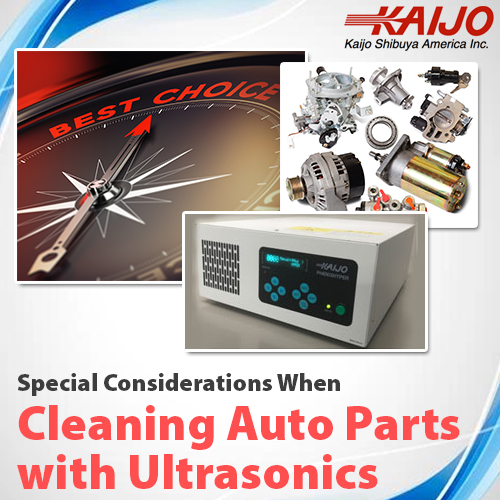Special Considerations When Cleaning Auto Parts with Ultrasonics
February 22, 2022
 When automotive parts are made from different materials and have several surface contaminants that have to be removed, cleaning with traditional methods can be difficult and time-consuming. Specialized automotive ultrasonic cleaners can be designed to deliver excellent cleaning in a shorter time. To remove specific contaminants, ultrasonic cleaners can work with mild detergents and solvents and can use a heated tank to improve cleaning performance. The key to successful cleaning with ultrasonics is to identify the part materials and the expected contaminants for a cleaning application and to get automotive ultrasonic cleaners that match the application requirements.
When automotive parts are made from different materials and have several surface contaminants that have to be removed, cleaning with traditional methods can be difficult and time-consuming. Specialized automotive ultrasonic cleaners can be designed to deliver excellent cleaning in a shorter time. To remove specific contaminants, ultrasonic cleaners can work with mild detergents and solvents and can use a heated tank to improve cleaning performance. The key to successful cleaning with ultrasonics is to identify the part materials and the expected contaminants for a cleaning application and to get automotive ultrasonic cleaners that match the application requirements.
How Cleaning Auto Parts with Ultrasonics Can Save Time and Money
Auto parts can be made from different materials and they often have irregular shapes. When parts are made from a combination of hard metals such as stainless steel, soft metal such as aluminum, or soft plastic, different cleaning options need to be considered depending on the surface contaminants. Traditional manual cleaning by scrubbing and scraping may work in some cases, however, this can damage the soft surfaces. Crevices, openings, and holes in parts may be inaccessible with traditional cleaning methods and may require soaking in strong chemicals. The result is that cleaning can take a lot of time and may be incomplete.
An automotive ultrasonic cleaner can clean such parts quickly and without damaging part surfaces. Ultrasonic cleaning cleans everywhere the cleaning solution can penetrate, along with complicated shapes and inside holes and crevices. Contaminants are removed completely and the systems can operate without supervision.
When using ultrasonic parts cleaners, operators can place the parts in the bath and set a timer. They can carry out other tasks and return later to take out the completely clean parts. Total time spent on cleaning is much less than with traditional methods, and all the costs associated with buying, storing, using, and disposing of chemicals and harsh cleaners are eliminated. Ultrasonics can improve parts cleaning at automotive manufacturing and restoration facilities and increase profitability.
How Ultrasonic Cleaners Can Match the Requirements of Automotive Parts Cleaning
Automotive ultrasonic cleaners can clean parts made from a mix of materials and alloys without damaging even the softest surfaces. This is especially important if parts have delicate coatings or soft, treated surfaces. The ultrasonic cleaning frequency can be selected to gently clean fragile surfaces by using higher frequencies. An experienced ultrasonic cleaner manufacturer can provide guidance with selecting the right frequency for a specific application that will deliver excellent cleaning without damaging any of the parts.
Once the ultrasonic frequency is chosen, the type of contaminants to be removed can influence ultrasonic cleaner operation. Ultrasonic cleaning systems can use mild detergents or solvents to help remove surface contaminants while a heated cleaning solution can be used to soften certain kinds of harder deposits. When a contaminant is hard to remove, a specific solvent can be used that will help dissolve the substance. The combination of ultrasonic cleaning, heat, and solvents or detergents is a powerful tool for effectively cleaning different types of automotive parts in a short time.
How to Select the Right Automotive Ultrasonic Cleaner
The most important factors to consider when choosing ultrasonic parts cleaners are the composition of the parts to be cleaned and the types of contaminants to be removed. The higher the ultrasonic frequency, the less aggressive the cleaning action, and this allows more delicate parts to be safely cleaned.
The less powerful cleaning performance can increase the time needed for cleaning, but the type of contaminant influences what additional measures can be applied to reduce the cleaning time. The use of heated baths and solvents or detergents improves cleaning performance and reduces the cleaning time. Balancing these two tendencies to obtain optimal performance from an automotive cleaning system is the key to effective cleaning outcomes.
Kaijo works with customers to ensure that they choose the right system based on the cleaning requirements for their specific application. When ultrasonic cleaners are correctly configured for the cleaning application, they will deliver the best cleaning performance. Contact Kaijo for a free consultation to determine which ultrasonic cleaning system will work best for your application.





